Switzerland - Canton of Aargau
1809 Silver 20 Batzen 34mm (14.70 grams)
Reference: HMZ 2# 20b, KM# 17
Certification: NGC MS 62 1524593-006
CANTON ARGAU, Pointed arms between laurel branches.
SCHWEIZERISCHE EIDSGENOSSENSCHAFT 1809 20.BATZ:, Seated soldier supporting shield. You are bidding on the exact item pictured, provided with a Certificate of Authenticity and Lifetime Guarantee of Authenticity.
Aargau, more formally Canton of Aargau, is one of the 26 cantons forming the Swiss Confederation. It is composed of eleven districts and its capital is Aarau. Aargau is one of the most northerly cantons of Switzerland. It is situated by the lower course of the Aare River, which is why the canton is called Aar-gau (meaning "Aare province"). It is one of the most densely populated regions of Switzerland. The area of Aargau and the surrounding areas were controlled by the Helvetians, a member of the Celts, as far back as 200 BC. was eventually occupied by the Romans and then by the 6th century, the Franks. Romans built a major settlement called Vindonissa, near the present location of Brugg. Medieval Aargau  The reconstructed Old High German name of Aargau is Argowe, first unambiguously attested (in the spelling Argue) in 795. The term described a territory only loosely equivalent to that of the modern canton, including the region between Aare and Reuss rivers, including Pilatus and Napf, i.e. including parts of the modern cantons of Bern (Bernese Aargau, Emmental, parts of the Bernese Oberland), Solothurn, Basel-Landschaft, Lucerne, Obwalden and Nidwalden, but not the parts of the modern canton east of the Reuss (Baden District), which were part of Zürichgau. The reconstructed Old High German name of Aargau is Argowe, first unambiguously attested (in the spelling Argue) in 795. The term described a territory only loosely equivalent to that of the modern canton, including the region between Aare and Reuss rivers, including Pilatus and Napf, i.e. including parts of the modern cantons of Bern (Bernese Aargau, Emmental, parts of the Bernese Oberland), Solothurn, Basel-Landschaft, Lucerne, Obwalden and Nidwalden, but not the parts of the modern canton east of the Reuss (Baden District), which were part of Zürichgau.
Within the Frankish Empire (8th to 10th centuries), the area was a disputed border region between the duchies of Alamannia and Burgundy. A line of the von Wetterau (Conradines) intermittently held the countship of Aargau from 750 until about 1030, when they lost it (having in the meantime taken the name von Tegerfelden). This division became the ill-defined (and sparsely settled) outer border of the early Holy Roman Empire at its formation in the second half of the 10th century. Most of the region came under the control of the ducal house of Zähringen and the comital houses of Habsburg and Kyburg by about 1200. In the second half of the 13th century, the territory became divided between the territories claimed by the imperial cities of Bern, Lucerne and Solothurn and the Swiss canton of Unterwalden. The remaining portion, largely corresponding to the modern canton of Aargau, remained under the control of the Habsburgs until the "conquest of Aargau" by the Old Swiss Confederacy in 1415. Castle itself, the original seat of the House of Habsburg, was taken by Bern in April 1415. Habsburgs had founded a number of monasteries (with some structures enduring, e.g., in Wettingen and Muri), the closing of which by the government in 1841 was a contributing factor to the outbreak of the Swiss civil war – the "Sonderbund War" – in 1847. Forming the canton of AargauThe contemporary canton of Aargau was formed in 1803, a canton of the Swiss Confederation as a result of the Act of Mediation. It was a combination of three short-lived cantons of the Helvetic Republic: Aargau (1798–1803), Baden (1798–1803) and Fricktal (1802–1803). Its creation is therefore rooted in the Napoleonic era. In the year 2003, the canton of Aargau celebrated its 200th anniversary. French forces occupied the Aargau from 10 March to 18 April 1798; thereafter the Bernese portion became the canton of Aargau and the remainder formed the canton of Baden. Aborted plans to merge the two halves came in 1801 and 1802, and they were eventually united under the name Aargau, was then admitted as a full member of the reconstituted Confederation following the Act of Mediation. Some parts of the canton of Baden at this point were transferred to other cantons: the Amt of Hitzkirch to Lucerne, whilst Hüttikon, Oetwil an der Limmat, Dietikon and Schlieren went to Zürich. In return, Lucerne's Amt of Merenschwand was transferred to Aargau (district of Muri). The Fricktal, ceded in 1802 by Austria via Napoleonic France to the Helvetic Republic, was briefly a separate canton of the Helvetic Republic (the canton of Fricktal) under a Statthalter ('Lieutenant'), but on 19 March 1803 (following the Act of Mediation) was incorporated into the canton of Aargau. The former cantons of Baden and Fricktal can still be identified with the contemporary districts – the canton of Baden is covered by the districts of Zurzach, Baden, Bremgarten, and Muri (albeit with the gains and losses of 1803 detailed above); the canton of Fricktal by the districts of Rheinfelden and Laufenburg (except for Hottwil which was transferred to that district in 2010). Chief magistracyThe chief magistracy of Aargau changed its style repeatedly: - first two consecutive Regierungsstatthalter :
- April 1798 – November 1801 Jakob Emmanuel Feer (1754–1833)
- 1802–1803 Johann Heinrich Rothpletz (1766–1833)
- Presidents of the Government Commission
- 10 March 1803 – 26 April 1803 Johann Rudolf Dolder (1753–1807)
- 26 April 1803 – 1815 a 'Small Council' (president rotating monthly)
- annual Amtsbürgermeister 1815–1831
- annual Landammänner since 1815
Jewish history in AargauTwo separate doors (one for Jews and one for Christians) on a house in Lengnau In the 17th century, Aargau was the only federal condominium where Jews were tolerated. In 1774, they were restricted to just two towns, Endingen and Lengnau. While the rural upper class pressed incessantly for the expulsion the Jews, the financial interests of the authorities prevented it. They imposed special taxes on peddling and cattle trading, the primary Jewish professions. The Protestant occupiers also enjoyed the discomfort of the local Catholics by the presence of the Jewish community. Jews were directly subordinate to the governor; from 1696, they were compelled to renew a letter of protection from him every 16 years. During this period, Jews and Christians were not allowed to live under the same roof, neither were Jews allowed to own land or houses. They were taxed at a much higher rate than others and, in 1712, the Lengnau community was "pillaged." 1760, they were further restricted regarding marriages and procreation. An exorbitant tax was levied on marriage licenses; oftentimes, they were outright refused. remained the case until the 19th century. In 1799, the Helvetic republic abolished all special tolls, and, in 1802, removed the poll tax. 5 May 1809, they were declared citizens and given broad rights regarding trade and farming. They were still restricted to Endingen and Lengnau until 7 May 1846, when their right to move and reside freely within the canton of Aargau was granted. On 24 September 1856, the Swiss Federal Council granted them full political rights within Aargau, as well as broad business rights; however the majority Christian population did not fully abide by these new liberal laws. The time of 1860 saw the canton government voting to grant suffrage in all local rights and to give their communities autonomy. Before the law was enacted, it was however repealed due to vocal opposition led by the Ultramonte Party. the federal authorities in July 1863, granted all Jews full rights of citizens. However, they did not receive all of the rights in Endingen and Lengnau until a resolution of the Grand Council, on 15 May 1877, granted citizens' rights to the members of the Jewish communities of those places, giving them charters under the names of New Endingen and New Lengnau. Swiss Jewish Kulturverein was instrumental in this fight from its founding in 1862 until it was dissolved 20 years later. this period of diminished rights, they were not even allowed to bury their dead in Swiss soil and had to bury their dead on an island called Judenäule (Jews' Isle) on the Rhine near Waldshut. in 1603, the deceased Jews of the Surbtal communities were buried on the river island which was leased by the Jewish community. As the island was repeatedly flooded and devastated, in 1750 the Surbtal Jews asked the Tagsatzung to establish the Endingen cemetery in the vicinity of their communities.
.svg/85px-Coat_of_Arms_of_Switzerland_(Pantone).svg.png) 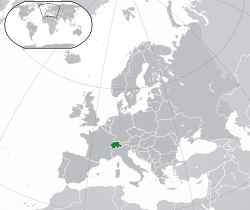 Switzerland, officially the Swiss Confederation (Latin: Confoederatio Helvetica, hence its abbreviation CH), is a federal parliamentary republic consisting of 26 cantons, with Bern as the seat of the federal authorities, the so-called Bundesstadt ("federal city"). The country is situated in Western and Central Europe, where it is bordered by Italy to the south, France to the west, Germany to the north, and Austria and Liechtenstein to the east. Switzerland is a landlocked country geographically divided between the Alps, the Swiss Plateau and the Jura, spanning an area of 41,285 km2 (15,940 sq mi). While the Alps occupy the greater part of the territory, the Swiss population of approximately 8 million people is concentrated mostly on the Plateau, where the largest cities are to be found. Among them are the two global cities and economic centres of Zürich and Geneva. Switzerland, officially the Swiss Confederation (Latin: Confoederatio Helvetica, hence its abbreviation CH), is a federal parliamentary republic consisting of 26 cantons, with Bern as the seat of the federal authorities, the so-called Bundesstadt ("federal city"). The country is situated in Western and Central Europe, where it is bordered by Italy to the south, France to the west, Germany to the north, and Austria and Liechtenstein to the east. Switzerland is a landlocked country geographically divided between the Alps, the Swiss Plateau and the Jura, spanning an area of 41,285 km2 (15,940 sq mi). While the Alps occupy the greater part of the territory, the Swiss population of approximately 8 million people is concentrated mostly on the Plateau, where the largest cities are to be found. Among them are the two global cities and economic centres of Zürich and Geneva.
The establishment of the Swiss Confederation is traditionally dated to 1 August 1291, which is celebrated annually as Swiss National Day. It has a long history of armed neutrality-it has not been in a state of war internationally since 1815-and did not join the United Nations until 2002. It pursues, however, an active foreign policy and is frequently involved in peace-building processes around the world. Switzerland is also the birthplace of the Red Cross and home to numerous international organizations, including the second largest UN office. On the European level, it is a founding member of the European Free Trade Association and is part of the Schengen Area - although it is notably not a member of the European Union, nor the European Economic Area. Switzerland comprises four main linguistic and cultural regions: German, French, Italian and the Romansh-speaking valleys. Therefore, the Swiss, although predominantly German-speaking, do not form a nation in the sense of a common ethnic or linguistic identity; rather, the strong sense of identity and community is founded on a common historical background, shared values such as federalism and direct democracy, and Alpine symbolism. Switzerland has the highest nominal wealth per adult (financial and non-financial assets) in the world according to Credit Suisse and eighth-highest per capita gross domestic product on the IMF list. However, Switzerland is also the most expensive country in the world to live in, as measured by the price level index. Swiss citizens have the second-highest life expectancy in the world on the UN DESA list. Switzerland is tied with the Netherlands for the top rank on the Bribe Payers Index indicating very low levels of business corruption. Moreover, for the last five years the country has been ranked first in economic and tourist competitiveness according to the Global Competitiveness Report and the Travel and Tourism Competitiveness Report respectively, both developed by the World Economic Forum. Zürich and Geneva have each been ranked among the top cities with the highest quality of life in the world, with the former coming second globally according to Mercer. However, Mercer also rates those two cities as the fifth- and sixth- most expensive cities in the world to live in.
|
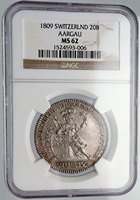
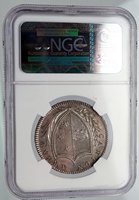
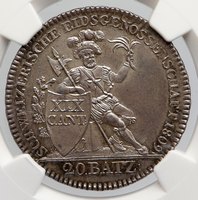
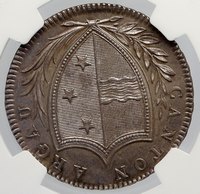
 The reconstructed Old High German name of Aargau is Argowe, first unambiguously attested (in the spelling Argue) in 795. The term described a territory only loosely equivalent to that of the modern canton, including the region between Aare and Reuss rivers, including Pilatus and Napf, i.e. including parts of the modern cantons of Bern (Bernese Aargau, Emmental, parts of the Bernese Oberland), Solothurn, Basel-Landschaft, Lucerne, Obwalden and Nidwalden, but not the parts of the modern canton east of the Reuss (Baden District), which were part of Zürichgau.
The reconstructed Old High German name of Aargau is Argowe, first unambiguously attested (in the spelling Argue) in 795. The term described a territory only loosely equivalent to that of the modern canton, including the region between Aare and Reuss rivers, including Pilatus and Napf, i.e. including parts of the modern cantons of Bern (Bernese Aargau, Emmental, parts of the Bernese Oberland), Solothurn, Basel-Landschaft, Lucerne, Obwalden and Nidwalden, but not the parts of the modern canton east of the Reuss (Baden District), which were part of Zürichgau.
.svg/85px-Coat_of_Arms_of_Switzerland_(Pantone).svg.png)
 Switzerland, officially the Swiss Confederation (Latin: Confoederatio Helvetica, hence its abbreviation CH), is a federal parliamentary republic consisting of 26 cantons, with Bern as the seat of the federal authorities, the so-called Bundesstadt ("federal city"). The country is situated in Western and Central Europe, where it is bordered by Italy to the south, France to the west, Germany to the north, and Austria and Liechtenstein to the east. Switzerland is a landlocked country geographically divided between the Alps, the Swiss Plateau and the Jura, spanning an area of 41,285 km2 (15,940 sq mi). While the Alps occupy the greater part of the territory, the Swiss population of approximately 8 million people is concentrated mostly on the Plateau, where the largest cities are to be found. Among them are the two global cities and economic centres of Zürich and Geneva.
Switzerland, officially the Swiss Confederation (Latin: Confoederatio Helvetica, hence its abbreviation CH), is a federal parliamentary republic consisting of 26 cantons, with Bern as the seat of the federal authorities, the so-called Bundesstadt ("federal city"). The country is situated in Western and Central Europe, where it is bordered by Italy to the south, France to the west, Germany to the north, and Austria and Liechtenstein to the east. Switzerland is a landlocked country geographically divided between the Alps, the Swiss Plateau and the Jura, spanning an area of 41,285 km2 (15,940 sq mi). While the Alps occupy the greater part of the territory, the Swiss population of approximately 8 million people is concentrated mostly on the Plateau, where the largest cities are to be found. Among them are the two global cities and economic centres of Zürich and Geneva.
